Measuring Neighbourhood Walking Access for Older Adults
Abstract
1. Introduction
2. Literature Review
3. Study Area and Dataset
3.1. Victorian Integrated Survey of Travel and Activity (VISTA)
3.2. Point of Interest (POIs)
3.3. Population Density
3.4. Walk Time
3.5. Land Use Mix (LUMIX)
3.6. Safety (Crash Rates)
3.7. Street Connectivity
4. Methodology
4.1. OWAI1
- WTSA1i = total walking time for older adults from SA1 centroid;
- WTjM = maximum walking time to destination j;
- WTjA = average walking time from an SA1-weighted centroid i to destination j;
- WTijD = desirable walking time to destination j;
- Ni = number of POIs within the walking range for older people.
- Pratio = Population ratio,
- n = types of POIs (Four types of POIs are considered in this study).
4.2. OWAI2
- LUMIX = land use mix score;
- Pi = the proportion of the area covered by land use j;
- n = the total number of land-use types.
5. Results
6. Discussions
7. Spatial Transferability and Implementation of OWAIs
7.1. Spatial Transferability of OWAI1
7.2. Implementation of OWAIs
8. Conclusions and Future Research Directions
Author Contributions
Funding
Institutional Review Board Statement
Informed Consent Statement
Data Availability Statement
Acknowledgments
Conflicts of Interest
References
- United Nations, Department of Economic and Social Affairs, Population Division. World Population Ageing, 2019: Highlights (ST/ESA/SER.A/430); United Nations, Department of Economic and Social Affairs, Population Division: New York, NJ, USA, 2019. [Google Scholar]
- Garrard, J. Senior Victorians and walking: Obstacles and opportunities; Final Report, 2013; The National Academies of Sciences, Engineering, and Medicine: Washington, DC, USA, 2013. [Google Scholar]
- Grant, G.; Machaczek, K.; Pollard, N.; Allmark, P. Walking, sustainability and health: Findings from a study of a Walking for Health group. Health Soc. Care Community 2017, 25, 1218–1226. [Google Scholar] [CrossRef] [PubMed]
- Kelly, P.; Williamson, C.; Niven, A.G.; Hunter, R.; Mutrie, N.; Richards, J. Walking on sunshine: Scoping review of the evidence for walking and mental health. Br. J. Sport. Med. 2018, 52, 800–806. [Google Scholar] [CrossRef] [PubMed]
- Barajas, J.M.; Braun, L.M. Are cycling and walking good for all? Tracking differences in associations among active travel, socioeconomics, gentrification, and self-reported health. J. Transp. Health 2021, 23, 101246. [Google Scholar]
- Watts, A.; Walters, R.W.; Hoffman, L.; Templin, J.; Buchowski, M. Intra-Individual Variability of Physical Activity in Older Adults with and without Mild Alzheimer’s Disease. PLoS ONE 2016, 11, 0153898. [Google Scholar]
- Black, S.V.; Cooper, R.; Martin, K.R.; Brage, S.; Kuh, D.; Stafford, M. Physical Activity and Mental Well-being in a Cohort Aged 60–64 Years. Am. J. Prev. Med. 2015, 49, 172–180. [Google Scholar] [CrossRef] [PubMed][Green Version]
- Branco, J.C.; Jansen, K.; Sobrinho, J.T.; Carrapatoso, S.; Spessato, B.; Carvalho, J.; Mota, J.; da Silva, R.A. Physical benefits and reduction of depressive symptoms among the older adult: Results from the Portuguese “National Walking Program”. Ciência Saúde Coletiva 2015, 20, 789–795. [Google Scholar] [CrossRef]
- McPhee, J.S.; French, D.P.; Jackson, D.; Nazroo, J.; Pendleton, N.; Degens, H. Physical activity in older age: Perspectives for healthy ageing and frailty. Biogerontology 2016, 17, 567–580. [Google Scholar] [CrossRef]
- Santinha, G.; Wolf, J.; Costa, C. Aging and the built environment: Is mobility constrained for institutionalized older adults? J. Urban. Int. Res. Placemaking Urban Sustain. 2020, 13, 431–447. [Google Scholar] [CrossRef]
- Masoumi, H.; Sierpiński, G. The Land Use and Individual Correlates of Pedestrian Commuting: Who Walks to Their Work or Place of Study in the Large Cities of the MENA Region? Sustainability 2022, 14, 6377. [Google Scholar] [CrossRef]
- Poblete, P.N.; Séguin, A.M.; Apparicio, P. Improving walkability for seniors through accessibility to food stores: A study of three areas of Greater Montreal. Int. Res. Placemaking Urban Sustain. 2016, 9, 51–72. [Google Scholar] [CrossRef]
- Nathan, A.; Pereira, G.; Foster, S.; Hooper, P.; Saarloos, D.; Corti, B.G. Access to commercial destinations within the neighborhood and walking among Australian older adults. Int. J. Behav. Nutr. Phys. Act. 2012, 9, 133. [Google Scholar] [CrossRef]
- Wong, R.C.P.; Szeto, W.Y.; Yang, L.; Li, Y.C.; Wong, S.C. Public transport policy measures for improving older adult mobility. Transp. Policy 2018, 63, 73–79. [Google Scholar] [CrossRef]
- Barnes, J.; Morris, A.; Welsh, R.; Summerskill, S.; Marshall, R.; Kendrick, D.; Logan, P.; Drummond, A.; Conroy, S.; Fildes, B.; et al. Injuries to older users of buses in the UK. Plan. Oper. 2016, 8, 25–38. [Google Scholar] [CrossRef]
- Wijlhuizen, G.J.; de Jong, R.; Hopman-Rock, M. Older persons afraid of falling reduces physical activity to prevent outdoor falls. Prev. Med. 2007, 44, 260–264. [Google Scholar] [CrossRef] [PubMed]
- Alves, F.; Cruz, S.; Ribeiro, A.; Silva, A.B.; Martins, J.; Cunha, I. Walkability Index for Elderly Health: A Proposal. Sustainability 2020, 12, 7360. [Google Scholar] [CrossRef]
- Gong, Y.; Gallacher, J.; Palmer, S.; Fone, D. Neighbourhood green space, physical function and participation in physical activities among older adult men: The Caerphilly Prospective study. Int. J. Behav. Nutr. Phys. Act. 2014, 11, 40. [Google Scholar] [CrossRef]
- Wu, J.; Song, Y.; Wang, H.L.; Zhang, F.; Li, F.H.; Wang, Z.Y. Influence of the built environment of Nanjing’s Urban Community on the leisure physical activity of the older adult: An empirical study. BMC Public Health 2019, 19, 1459. [Google Scholar] [CrossRef] [PubMed]
- Kim, S.; Ulfarsson, G. Travel mode choice of the older adult: Effects of personal, household, neighborhood, and trip characteristics. Transp. Res. Rec. 2004, 1894, 117–126. [Google Scholar] [CrossRef]
- Campisi, T.; Ignaccolo, M.; Inturri, G.; Tesoriere, G.; Torrisi, V. Evaluation of walkability and mobility requirements of visaually impaired people in urban spaces. Res. Transp. Bus. Manag. 2021, 40, 100592. [Google Scholar] [CrossRef]
- Ewing, R.; Schmid, T.; Killingsworth, R.; Zlot, A.; Raudenbush, S. Relationship Between Urban Sprawl and Physical Activity, Obesity, and Morbidity. Am. J. Health Promot. 2003, 18, 47–57. [Google Scholar] [CrossRef] [PubMed]
- Saelens, B.E.; Sallis, J.F.; Black, J.B.; Chen, D. Neighborhood-Based Differences in Physical Activity: An Environment Scale Evaluation. Am. J. Health Promot. 2003, 93, 1552–1558. [Google Scholar] [CrossRef] [PubMed]
- Frank, L.D.; Schmid, T.L.; Sallis, J.F.; Chapman, J.; Saelens, B.E. Linking objectively measured physical activity with objectively measured urban form: Findings from SMARTRAQ. Am. J. Prev. Med. 2005, 28, 117–125. [Google Scholar] [CrossRef] [PubMed]
- Löllgen, H.; Böckenhoff, A.; Knapp, G. Physical Activity and All-cause Mortality: An Updated Meta-analysis with Different Intensity Categories. Int. J. Sport. Med. 2009, 30, 213–224. [Google Scholar] [CrossRef] [PubMed]
- Maghelal, P.; Capp, C.J. Walkability: A Review of Existing Pedestrian Indices. J. Urban Reg. Inf. Syst. Assoc. 2001, 23, 5–19. [Google Scholar]
- Loef, M.; Walach, H. The combined effects of healthy lifestyle behaviors on all-cause mortality: A systematic review and meta-analysis. Prev. Med. 2012, 55, 163–170. [Google Scholar] [CrossRef] [PubMed]
- Notthoff, N.; Carstensen, L.L. Promoting walking in older adults: Perceived neighborhood walkability influences the effectiveness of motivational messages. J. Health Psychol. 2015, 22, 834–843. [Google Scholar] [CrossRef] [PubMed]
- Vale, D.S.; Saraiva, M.; Pereira, M. Active accessibility: A review of operational measures of walking and cycling accessibility. J. Transp. Land Use 2016, 9, 1–27. [Google Scholar] [CrossRef]
- Lewinson, T.; Esnard, A.M. Resource Accessibility and Walkability Among Older Adults in Extended-Stay Hotels. J. Hous. Elder. 2015, 29, 396–418. [Google Scholar] [CrossRef]
- de Groot, L.C.P.M.G.; Verheijden, M.W.; de Henauw, S.; Schroll, M.; van Staveren, W.A. Lifestyle, Nutritional status, health, and mortality in Elderly adult across Europe: A review of the longitudinal results of the SENECA study. J. Gerontol. Ser. A: Biol. Sci. Med. Sci. 2004, 59, 1277–1284. [Google Scholar] [CrossRef]
- Wu, H.C.; Tseng, M.H. Evaluating Disparities in Older adult Community Care Resources: Using a Geographic Accessibility and Inequality Index. Int. J. Environ. Res. Public Health 2018, 15, 1353. [Google Scholar] [CrossRef]
- Bandini, S.; Crociani, L.; Gorrini, A.; Nishinari, K.; Vizzari, G. Walkability Assessment for the Elderly Through Simulations: The LONGEVICITY Project. In Proceedings of the 17th International Conference of the Italian Association for Artificial Intelligence-AI*IA 2018, Trento, Italy, 20–23 November 2018; Volume 2333, pp. 83–91. [Google Scholar]
- Cao, X.J.; Ettema, D.F. Satisfaction with travel and residential self-selection: How do preferences moderate the impact of the Hiawatha Light Rail Transit line? J. Trans. Land Use 2014, 7, 93–108. [Google Scholar] [CrossRef]
- Gallagher, N.A.; Clarke, P.J.; Ronis, D.L.; Cherry, C.L.; Nyquist, L.; Gretebeck, K.A. Influences on Neighborhood Walking in Older Adults. Res. Gerontol. Nurs. 2012, 5, 238–250. [Google Scholar] [CrossRef] [PubMed]
- Fatima, K.; Moridpour, S.; De Gruyter, C.; Saghapour, T. Elderly Sustainable Mobility: Scientific Paper Review. Sustainability 2020, 12, 7319. [Google Scholar] [CrossRef]
- Duncan, D.T.; Méline, J.; Kestens, Y.; Day, K.; Elbel, B.; Trasande, L.; Chaix, B. Walk Score, Transportation Mode Choice, and Walking Among French Adults: A GPS, Accelerometer, and Mobility Survey Study. Int. J. Environ. Res. Public Health 2016, 13, 611. [Google Scholar] [CrossRef] [PubMed]
- Giles-Corti, B.; Macaulay, G.; Middleton, N.; Boruff, B.; Bull, F.; Butterworth, I.; Badland, H.; Mavoa, S.; Roberts, R.; Christian, H. Developing a research and practice tool to measure walkability: A demonstration project. Health Promot. J. Aust. 2014, 25, 160–166. [Google Scholar] [CrossRef] [PubMed]
- Mavoa, S.; Badland, H.; Learnihan, V.; Boruff, B.; Pettit, C.; Astell-Burt, T.; Feng, X.; Hooper, P.; Rachele, J.; Eagleson, S.; et al. The Australian National Liveability Study Final Report; Healthy Liveable Cities Group, Centre for Urban Research, RMIT University: Mlebourne, Australia, 2016. [Google Scholar]
- Gao, C.; Yu, J.; Zhao, X.; Wang, H.; Liu, Z.; Gu, Y. The Effect of Built Environment on Older People Leisure-Time Walking and Physical Activity in Different Sex Groups in the City of Ningbo, China. Sustainability 2022, 14, 6562. [Google Scholar] [CrossRef]
- Koschinsky, J.; Talen, E.; Alfonzo, M. How walkable is Walker’s paradise? Environ. Plan. B Urban Anal. City Sci. 2017, 44, 343–363. [Google Scholar] [CrossRef]
- Boakye-Dankwa, E.; Nathan, A.; Barnett, A.; Busija, L.; Lee, R.S.Y.; Pachana, N.; Turrell, G.; Cerin, E. Walking behaviour and patterns of perceived access to neighbourhood destinations in older adults from a low-density (Brisbane, Australia) and an ultra-dense city (Hong Kong, China). Cities 2019, 84, 23–33. [Google Scholar] [CrossRef]
- Cheng, L.; Caset, F.; De, V.J.; Derudder, B.; Witlox, F. Investigating walking accessibility to recreational amenities for older adult adult in Nanjing, China. Transp. Res. Part D Transp. Environ. 2019, 76, 85–99. [Google Scholar] [CrossRef]
- Zhang, L.; Yin, Z.; Chen, C.; Hu, H.; Liu, H. Accessibility Evaluation and Layout Optimization of Urban Parks in Xihu District, Nanchang City Based on Walking of the Older adult Adult. J. Landsc. Res. 2020, 12, 53–57. [Google Scholar]
- Zhou, Y.; Yuan, Q.; Yang, C. Transport for the Elderly: Activity Patterns, Mode Choices, and Spatiotemporal Constraints. Sustainability 2020, 12, 10024. [Google Scholar] [CrossRef]
- Alves, F.; Cruz, S.; Rother, S.; Strunk, T. An Application of the Walkability Index for Elderly Health—WIEH. The Case of the UNESCO Historic Centre of Porto, Portugal. Sustainability 2021, 13, 4869. [Google Scholar]
- Yun, H. Neighborhood Built Environments, Walking, and Self-Rated Health among Low-Income Older Adults in St. Paul, Minnesota. Sustainability 2021, 13, 3501. [Google Scholar] [CrossRef]
- Hatamzadeh, Y.; Hosseinzadeh, A. Toward a deeper understanding of older adult walking for transport: An analysis across genders in a case study of Iran. J. Trans. Health 2020, 19, 100949. [Google Scholar] [CrossRef]
- McIntosh, G.; Phillips, J. Caring for the Elderly’-an Overview of Aged Care Support and Services in Australia; Parliament of Australia: Canberra, Australia, 2013. [Google Scholar]
- Parliamentary_Departments. Available online: https://www.aph.gov.au/About_Parliament/Parliamentary_Departments/Parliamentary_Library/Publications_Archive/archive/agedcare (accessed on 12 October 2022).
- Leung, K.M.; Chung, P.K.; Wang, D.; Liu, J.D. Impact of physical and social environments on the walking behaviour of Hong Kong’s older adults. J. Transp. Health 2018, 9, 299–308. [Google Scholar] [CrossRef]
- Koohsari, M.J.; Nakaya, T.; Oka, K. Activity-Friendly Built Environments in a Super-Aged Society, Japan: Current Challenges and toward a Research Agenda. Int. J. Environ. Res. Public Health 2018, 15, 2054. [Google Scholar] [CrossRef]
- Gaglione, F.; Gargiulo, C.; Zucaro, F. Where can the elderly walk? A spatial multi-criteria method to increase urban pedestrian accessibility. Cities 2022, 127, 103724. [Google Scholar]
- Guida, C.; Gargiulo, C.; Caglioni, M.; Carpentieri, G. Urban Accessibility to Healthcare Facilities for the Elderly: Evolution of the Time-Based 2SFCA Methodology for the Nice Case Study (France). In Computational Science and Its Application –ICCSA 2021. ICCSA 2021; Lecture Notes in Computer Science, 12958; Springer: Cham, Switzerland, 2021. [Google Scholar]
- Apparicio, P.; Abdelmajid, M.; Riva, M.; Shearmur, R. Comparing alternative approaches to measuring the geographical accessibility of urban health services: Distance types and aggregation-error issues. Int. J. Health Geogr. 2008, 7, 7. [Google Scholar] [CrossRef] [PubMed]
- Owen, N.; Cerin, E.; Leslie, E.; Dutoit, L.; Co_ee, N.; Frank, L.D.; Bauman, A.E.; Hugo, G.; Saelens, B.E.; Sallis, J.F. Neighborhood walkability and the walking behavior of australian adults. Am. J. Prev. Med. 2007, 33, 387–395. [Google Scholar] [CrossRef] [PubMed]
- Sundquist, K.; Eriksson, U.; Kawakami, N.; Skog, L.; Ohlsson, H.; Arvidsson, D. Neighborhood walkability, physical activity, and walking behavior: The Swedish neighborhood and physical activity (SNAP) study. Soc. Sci. Med. 2011, 72, 1266–1273. [Google Scholar] [CrossRef]
- Peiravian, F.; Derrible, S.; Ijaz, F. Development and application of the pedestrian environment index (PEI). J. Transp. Geogr. 2014, 39, 73–84. [Google Scholar] [CrossRef]
- Loo, B.P.Y.; Lam, W.W.Y. Geographic Accessibility around Health Care Facilities for Elderly Residents in Hong Kong: A Microscale, Walkability Assessment. Environ. Plan. B Plan. Des. 2012, 39, 629–646. [Google Scholar]
- Koh, P.P.; Leow, B.W.; Wong, Y.D. Mobility of the older adult in densely populated neighbourhoods in Singapore. Sustain. Cities Soc. 2015, 14, 126–132. [Google Scholar] [CrossRef]
- Yang, Y.; Ana, V.D. Walking Distance by Trip Purpose and Population Subgroups. Am. J. Prev. Med. 2012, 43, 11–19. [Google Scholar] [CrossRef] [PubMed]
- Bivina, G.R.; Gupta, A.; Parida, M. Walk Accessibility to Metro Stations: An analysis based on Meso- or Micro-scale Built Environment Factors. Sustain. Cities Soc. 2020, 55, 102047. [Google Scholar] [CrossRef]
- Yang, Y. A dynamic framework on travel mode choice focusing on utilitarian walking based on the integration of current knowledge. J. Transp. Health 2016, 3, 336–345. [Google Scholar] [CrossRef] [PubMed][Green Version]
- Böcker, L.; van Amen, P.; Helbich, M. Elderly travel frequencies and transport mode choices in Greater Rotterdam, the Netherlands. Transportation 2016, 44, 831–852. [Google Scholar] [CrossRef]
- Bereitschaft, B. Walk Score® versus residents’ perceptions of walkability in Omaha, NE. J. Urban. Int. Reasch. Placemaking Urban Sustain. 2018, 11, 412–435. [Google Scholar] [CrossRef]
- Habibian, M.; Hosseinzadeh, A. Walkability index across trip purposes. Sustain. Cities Soc. 2018, 42, 216–225. [Google Scholar] [CrossRef]
- Frank, L.D.; Sallis, J.F.; Saelens, B.E.; Leary, L.; Cain, K.; Conway, T.L.; Hess, P.M. The development of a walkability index: Application to the Neighborhood Quality of Life Study. Br. J. Sports Med. 2010, 44, 924–933. [Google Scholar] [CrossRef] [PubMed]
- Christian, H.E.; Bull, F.C.; Middleton, N.J.; Knuiman, M.W.; Divitini, M.L.; Hooper, P.; Amarasingh, A.; Corti, B.G. How important is the land use mix measure in understanding walking behaviour? Results from the RESIDE study. Int. J. Behav. Nutr. Phys. Act. 2011, 8, 1–12. [Google Scholar] [CrossRef] [PubMed]
- Manaugh, K.; Geneidy, A.E. Validating walkability indices: How do different households respond to the walkability of their neighborhood? Transp. Res. Part D Transp. Environ. 2011, 16, 309–315. [Google Scholar] [CrossRef]
- Carlson, J.A.; Sallis, J.F.; Conway, T.L.; Saelens, B.E.; Frank, L.D.; Kerr, J.; Cain, K.L.; King, A.C. Interactions between psychosocial and built environment factors in explaining older adults’ physical activity. Prevent. Med. 2012, 54, 68–73. [Google Scholar] [CrossRef] [PubMed]
- Glazier, R.; Weyman, J.; Creatore, M.; Gozdyra, P.; Moineddin, R.; Matheson, F. Development and validation of an urban walkability index for Toronto, Canada. Tor. Community Health Profiles Partnersh. 2012, 1–21. [Google Scholar]
- Coffee, N.T.; Howard, N.; Paquet, C.; Hugo, G.; Daniel, M. Is walkability associated with a lower cardiometabolic risk? Health Place 2013, 21, 163–169. [Google Scholar] [CrossRef]
- Brewer, C.A.; Pickle, L. Evaluation of Methods for Classifying Epidemiological Data on Choropleth Maps in Series. Ann. Assoc. Am. Geogr. 2002, 92, 662–681. [Google Scholar] [CrossRef]
- Reyer, M.; Fina, S.; Siedentop, S.; Schlicht, W. Walkability is Only Part of the Story: Walking for Transportation in Stuttgart, Germany. Int. J. Environ. Res. Public Health 2014, 11, 5849–5865. [Google Scholar] [CrossRef]
- Fatima, K.; Moridpour, S.; Saghapour, T. Development of a Public Transport Accessibility Index for Older Commuters: A Time-Based Approach. J. Adv. Transp. 2022, 2022, 1–15. [Google Scholar] [CrossRef]
- Victorian Integrated Survey of Travel and Activity (VISTA). Department of Transport: Melbourne, VIC, Australia, 2016. Available online: https://transport.vic.gov.au/ (accessed on 12 October 2022).
- ArcMap 1071 [GIS Software], Version 1071; Environmental Systems Research Institute, Inc.: Redlands, CA, USA, 2019. Available online: https://desktop.arcgis.com/en/arcmap/latest (accessed on 12 October 2022).
- Fatima, K.; Moridpour, S. Measuring Public Transport Accessibility for Older people. In Proceedings of the 6th International Conference on Traffic and Logistic Engineering (ICTLE 2018), Bangkok, Thailand, 3–5 August 2018; Volume 259, pp. 3006–3011. [Google Scholar]
- Australian Urban Research Infrastructure Network (AURIN). Available online: https://aurin.org.au (accessed on 12 October 2022).
- Azimi, N. Restructuring urban morphology, a case study of Rasht in Iran. Geogr. Res. 2005, 53, 13–25. [Google Scholar]
- Graham, J.; Fisher, S.; Bergés, I.; Kuo, Y.; Ostir, G. Walking Speed Threshold for Classifying Walking Independence in Hospitalized Older Adults. Phys. Ther. 2010, 90, 1591–1597. [Google Scholar] [CrossRef]
- Brewer, C.A.; Julius, L.M.; Brach, J.S.; Wert, D.M.; VanSwearingen, J.M. Perceived Effort of Walking: Relationship With Gait, Physical Function and Activity, Fear of Falling, and Confidence in Walking in Older Adults With Mobility Limitations. Phys. Ther. 2012, 92, 1268–1277. [Google Scholar]
- Yang, Y.; He, D.; Gou, Z.; Wang, R.; Liu, Y.; Lu, Y. Association between street greenery and walking behavior in older adults in Hong Kong. Sust. Cities Soc. 2019, 51, 101747. [Google Scholar] [CrossRef]
- Mantilla, J.; Burtt, D. Safer Road Design for Older Pedestrians, Version 1.1; Victoria Walks: Melbourne, Australia, 2016. [Google Scholar]
- Trova, V. Measures of Street Connectivity: Spatialist_Lines (MoSC). In Accessibility Instruments for Planning Practice; Dept. of Architecture, University of Thessaly, Greece: Volos, Greece, 2012; pp. 103–109. [Google Scholar]
- Zlatkovica, M.; Zlatkovicb, S.; Sullivan, T.; Bjornstad, J.; Shahandashtie, S.K.F. Assessment of effects of street connectivity on traffic performance and sustainability within communities and neighborhoods through traffic simulation. Sustain. Cities Soc. 2019, 46, 101409. [Google Scholar] [CrossRef]
- Ringard, J.; Frederique, S.; Laurent, L. A Quantile Mapping Bias Correction Method Based on Hydroclimatic Classification of the Guiana Shield. Sensors 2017, 17, 1413. [Google Scholar] [CrossRef]
- Saghapour, T.; Moridpour, S. The role of neighbourhoods accessibility in residential mobility. Cities 2019, 87, 1–9. [Google Scholar] [CrossRef]
- Saghapour, T.; Moridpour, S.; Russell, G.T. Transportation Research Record. J. Transp. Res. Board 2017, 2661, 111–119. [Google Scholar] [CrossRef]
- Authorities, T. Application of Accessibility Measures; Report AP-R397-11; Austroads: Sydney, NSW, Australia, 2011. [Google Scholar]
- Fatima, K.; Moridpour, S.; Saghapour, T.; DeGruyter, C. Measuring access to sustainable transport options for the elderly. In Proceedings of the 10th International Conference on Geotechnique, Construction Materials and Environment, Melbourne, Australia, 11–13 November 2020. [Google Scholar]
- Hess, D.B. Access to public transit and its influence on ridership for older adults in two US cities. J. Transp. Land Use 2009, 2, 3–27. [Google Scholar] [CrossRef]
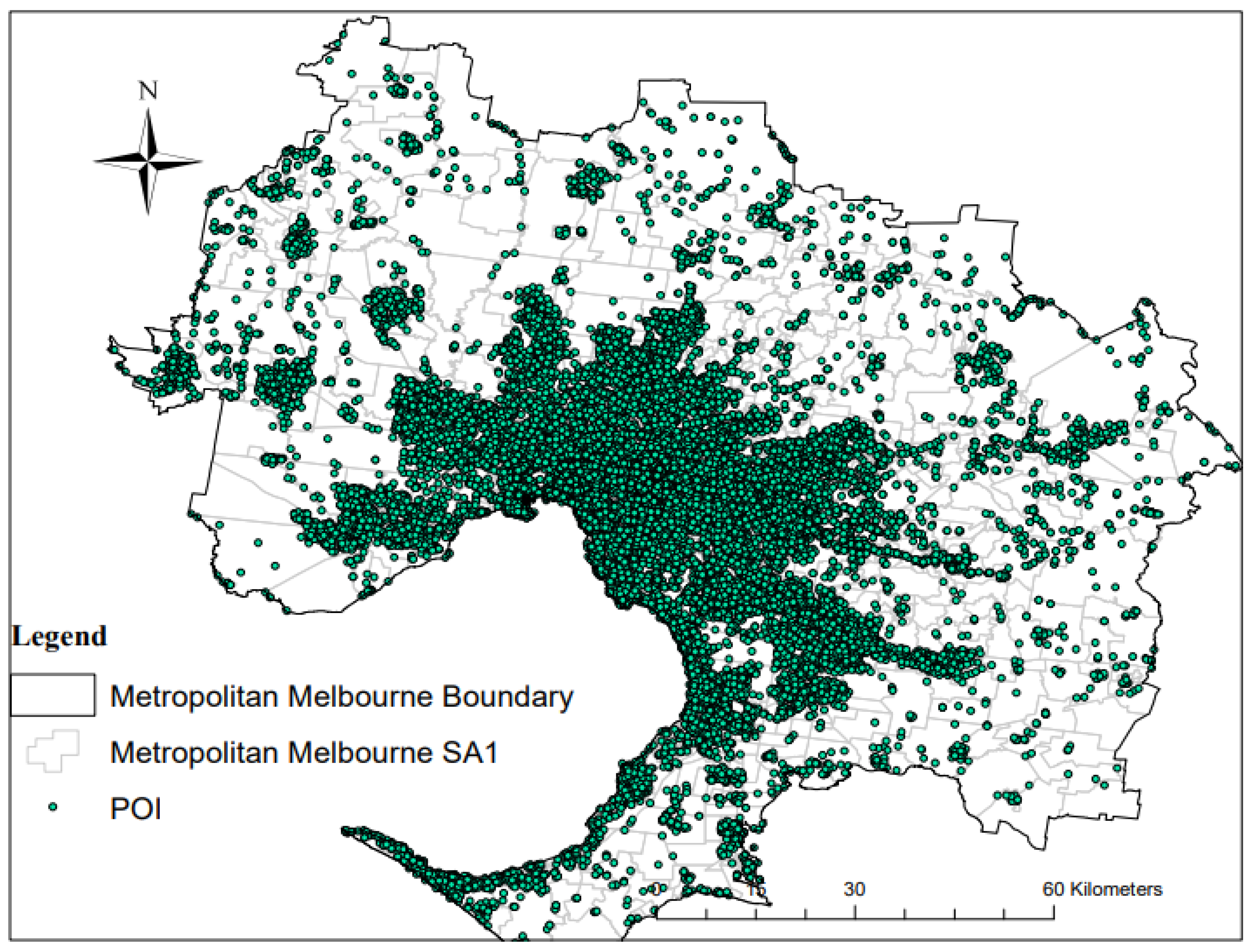
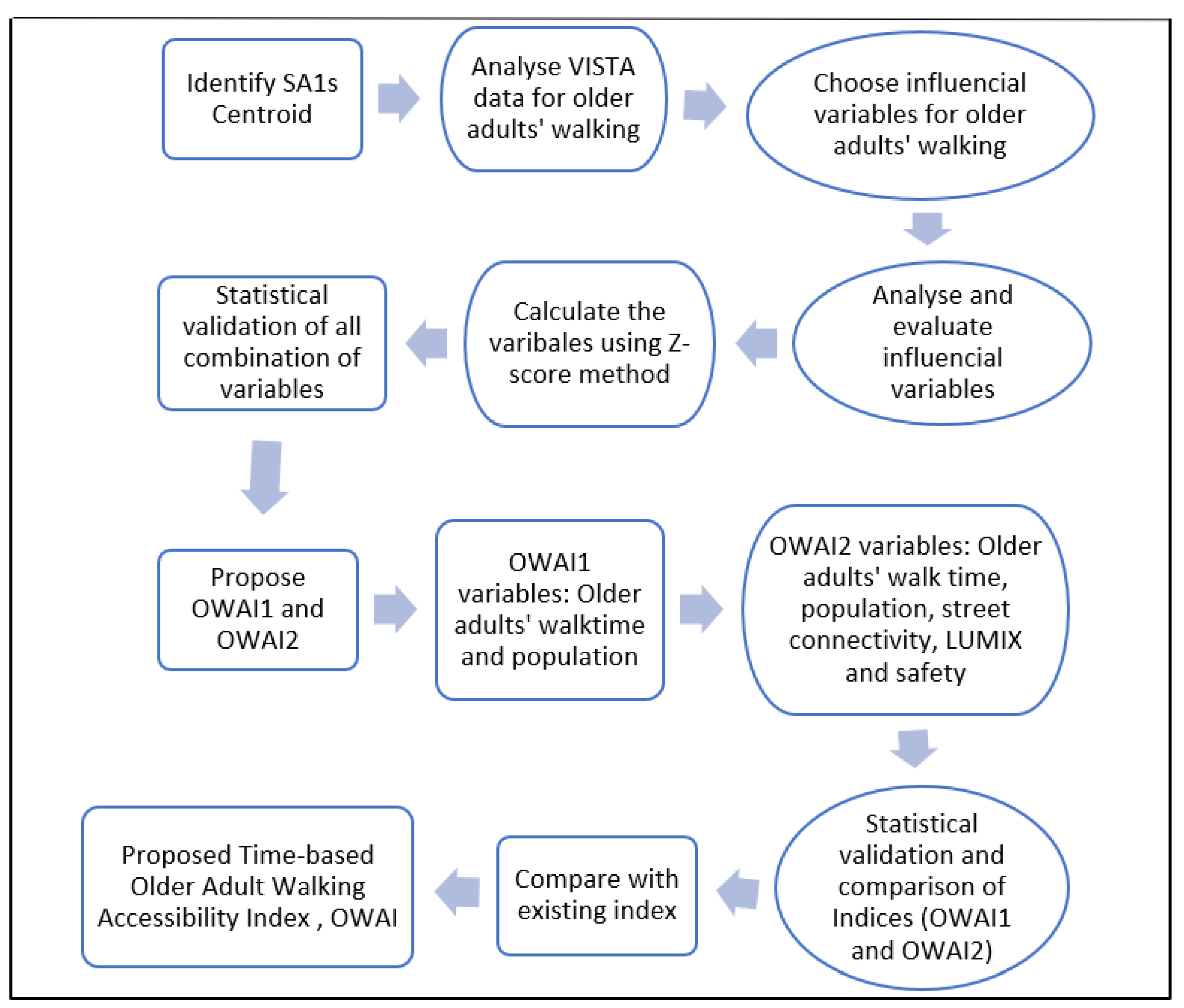


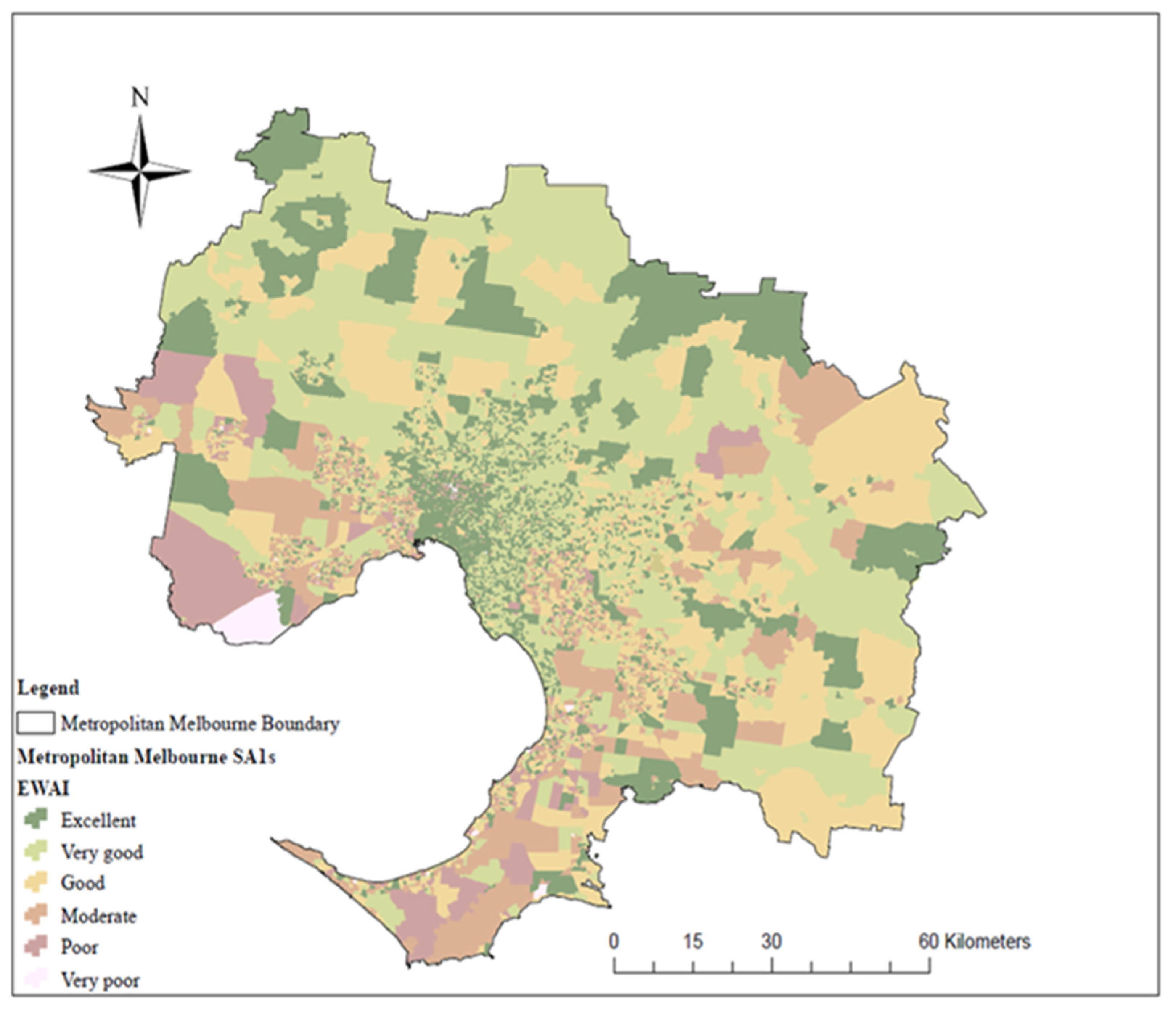
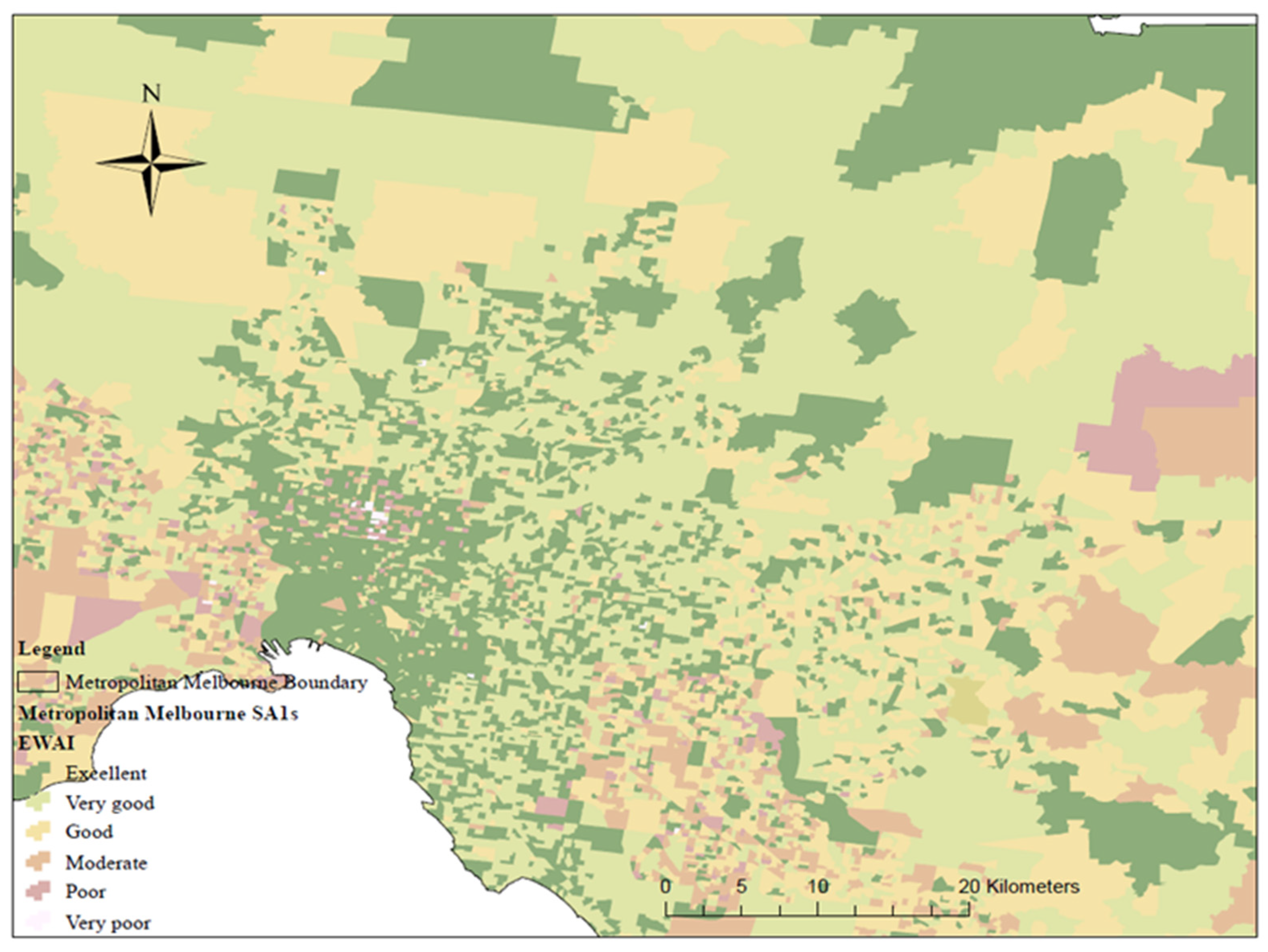
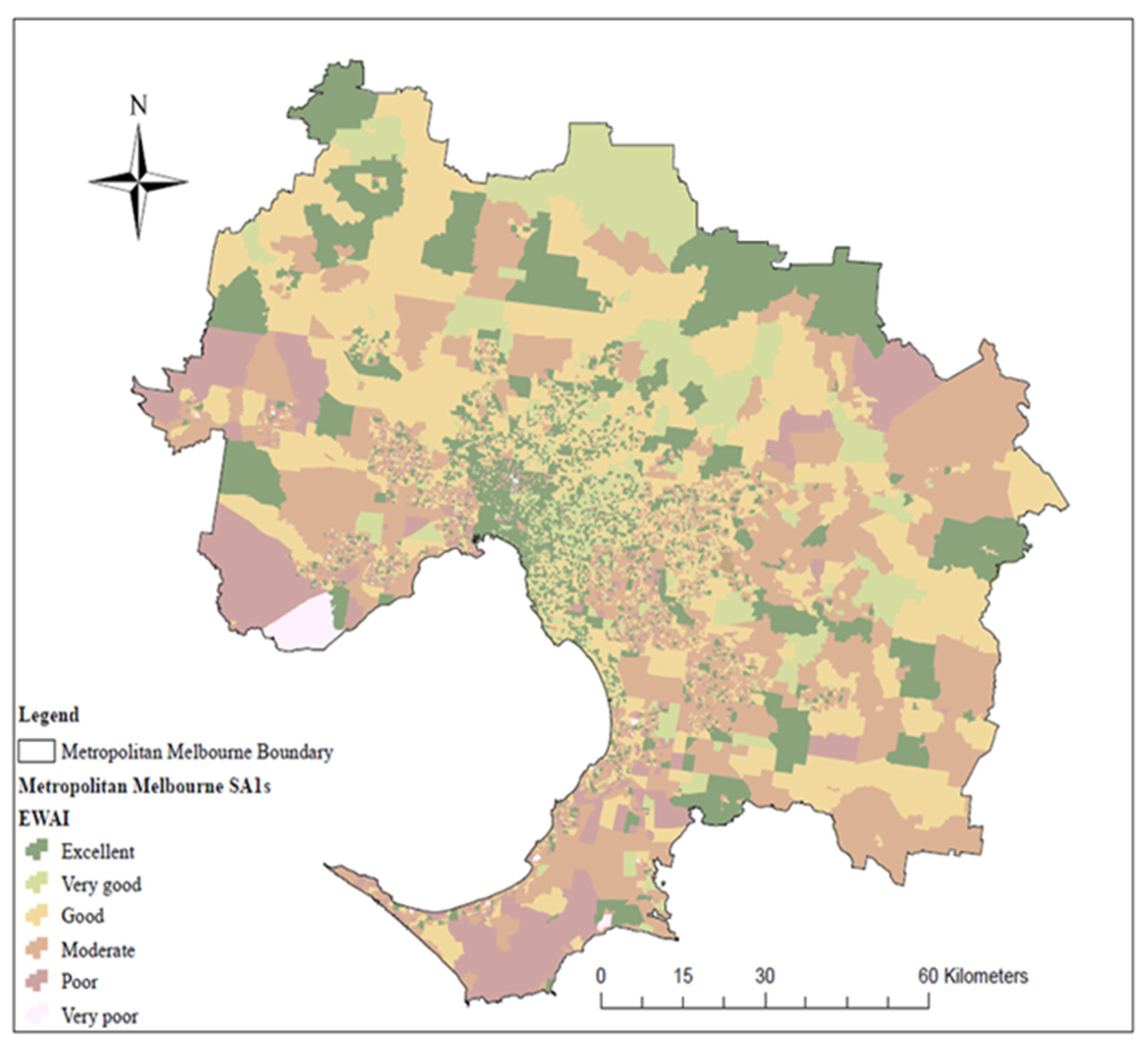
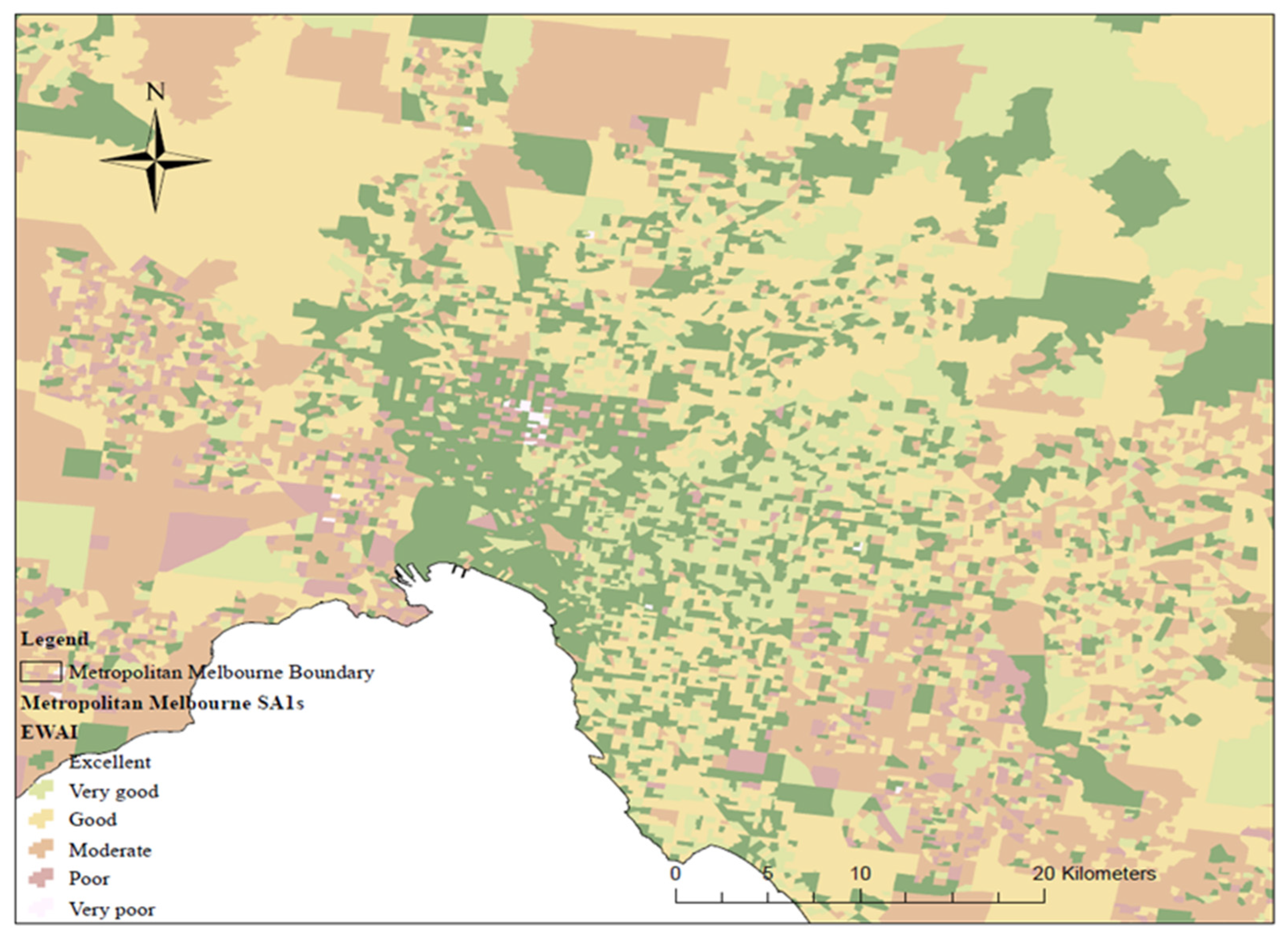
| Index and References | Definition and Highlights |
|---|---|
| Distance-based accessibility [29,43,55] | This method considers the distance between two specific points. (1) distance to the closest destination, (2) the number of destinations within specific meters or minutes, (3) the mean distance to all distances, and (4) the mean distance to the closest distance. |
| Time-based accessibility [54] | The method considers the actual availability of mobility for older people and their travel choices within different timeslots. |
| Gravity-based accessibility [29] | Newton’s theory of gravity was followed by Gravity-based measures. This method considers that the trips produced at an origin and attracted to a destination are directly proportional to the total trip productions at the origin and the total attractions at the destination. This measure is based on the spatial distribution of residence and travel time/cost between zones. The basic gravity model used by Hanson is: Where aj is the attraction in zone j, dij is the travel time, distance or cost from zone i to zone j, f(dij) is the impedance function, and A is a standardizing factor. |
| Topological or Infrastructure based [29] | This method does not focus on the origin and destination of the neighbourhood. It considers an analysis of network connectivity and/or the characteristics of the walking infrastructures. |
| Walkability/walk score-type measures [21,27] | This measure considers build-in-environment and accessibility from an origin to a destination |
| Walk Score [41] | One of the most common approaches for walkability is Walk Score. The Walk Score considers the distance to the closest destination in each land use category. It is based on the gravity-based model |
| Walkability Index (WI) [38,56,57,58,67,74] | The WI considered dwelling density, street connectivity, land use mix (LUMIX) and net retail areas. The WI is calculated from the sum of the z-scores of the four mentioned urban form measures. The typical form of the WI is as follows: WI = (Z-scoreLUMIX) + (Z-ScoreResidential Density) + (Z-ScoreStreet Connectivity) |
| Population in SA1 | Minimum * | Maximum | Standard Deviation | Mean |
|---|---|---|---|---|
| Older adults | 0 | 778 | 48.578 | 82.260 |
| Total Population | 0 | 4354 | 208.076 | 435.843 |
| Commuters | Desirable * Walk Time (Mean) | Maximum ** Walk Time (Mean) |
|---|---|---|
| Older travelers | 5.83 | 11.6 |
| Other travelers *** | <10 | <20 |
| Statistics Test | OWAI1 Statistics Value (Observed) | p-Value | OWAI2 Statistics Value (Observed) | p-Value | |
|---|---|---|---|---|---|
| Chi-Square Tests | Pearson Chi-Square, χ2 | 32.38 | 0.000 | 21.62 | 0.000 |
| Likelihood Ratio | 24.89 | 0.000 | 18.00 | 0.000 | |
| Symmetric Measures | |||||
| Nominal by Nominal | Phi | 0.63 | 0.000 | 0.52 | 0.000 |
| Cramer’s V | 0.45 | 0.000 | 0.37 | 0.000 | |
| Contingency Coefficient | 0.54 | 0.000 | 0.46 | 0.000 | |
| Statistics Test | OWAI1 Statistics | OWAI2 Statistics | WI Statistics | |
|---|---|---|---|---|
| Chi-Square Tests | Pearson Chi-Square, χ2 | 32.38 | 21.62 | 16.58 |
| Likelihood Ratio | 24.89 | 18.00 | 16.65 | |
| Symmetric Measures | ||||
| Nominal by nominal | Phi | 0.63 | 0.52 | 0.45 |
| Cramer’s V | 0.45 | 0.37 | 0.32 | |
| Contingency Coefficient | 0.54 | 0.46 | 0.41 | |
| Index Range | OWAI1 Accessibility SA1s (%) | ||
|---|---|---|---|
| Accessibility Group | Quantile Method | Natural Breaks (Jenks) | Geometrical Interval |
| Very poor | 27.21 | 15.77 | 26.16 |
| Poor | 17.52 | 12.07 | 20.71 |
| Moderate | 13.37 | 14.76 | 13.66 |
| Good | 11.21 | 5.32 | 13.15 |
| Very Good | 16.39 | 25.12 | 9.76 |
| Excellent | 14.30 | 26.96 | 16.60 |
| SA1s Accessibility (%) | ||||||
|---|---|---|---|---|---|---|
| POIs | Very Poor | Poor | Moderate | Good | Very Good | Excellent |
| Shopping Center | 43.7 | 23.0 | 10.5 | 11.5 | 5.7 | 5.8 |
| Health Care Center | 33.7 | 25.7 | 14.3 | 9.4 | 15. 7 | 11.3 |
| Education Center | 9.9 | 7.8 | 4.8 | 18.0 | 23.7 | 35.9 |
| Recreation Center | 3.3 | 4.7 | 10.9 | 8.2 | 23. 5 | 49.0 |
| Melbourne Elderly Walking Accessibility (%) | |||
|---|---|---|---|
| Access Level | Inner | Middle | Outer |
| Very Poor | 3.29 | 4.56 | 23.27 |
| Poor | 8.64 | 5.71 | 21.57 |
| Moderate | 11.74 | 9.87 | 15.86 |
| Good | 31.93 | 29.34 | 16.77 |
| Excellent | 44.40 | 50.52 | 22.53 |
Publisher’s Note: MDPI stays neutral with regard to jurisdictional claims in published maps and institutional affiliations. |
© 2022 by the authors. Licensee MDPI, Basel, Switzerland. This article is an open access article distributed under the terms and conditions of the Creative Commons Attribution (CC BY) license (https://creativecommons.org/licenses/by/4.0/).
Share and Cite
Fatima, K.; Moridpour, S.; Saghapour, T. Measuring Neighbourhood Walking Access for Older Adults. Sustainability 2022, 14, 13366. https://doi.org/10.3390/su142013366
Fatima K, Moridpour S, Saghapour T. Measuring Neighbourhood Walking Access for Older Adults. Sustainability. 2022; 14(20):13366. https://doi.org/10.3390/su142013366
Chicago/Turabian StyleFatima, Kaniz, Sara Moridpour, and Tayebeh Saghapour. 2022. "Measuring Neighbourhood Walking Access for Older Adults" Sustainability 14, no. 20: 13366. https://doi.org/10.3390/su142013366
APA StyleFatima, K., Moridpour, S., & Saghapour, T. (2022). Measuring Neighbourhood Walking Access for Older Adults. Sustainability, 14(20), 13366. https://doi.org/10.3390/su142013366







